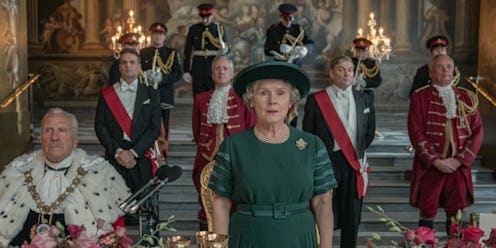Royals
The Crown's “Annus Horribilis” Speech Is Wildly Different From Reality
There are some things that Queen Elizabeth did not in fact say.

Over the years, The Crown has been the subject of a lot of discussion around its portrayal of the royal family and events throughout history. While the show is meant to be a dramatisation of real-life events, viewers tend to be left curious as to what’s fact and what’s fiction, and Season 5 has been embroiled in some controversies as a result. Prior to its release, former Prime Ministers Tony Blair and John Major condemned the show, with Major calling it “malicious fiction.”
However, one of the most evident shifts away from fact is the show’s portrayal of Queen Elizabeth’s historic “Annus horribilis” speech from 1992. The monarch marked 40 years since her ascension to the throne by delivering a speech at Guildhall and this is captured in the fourth episode of Season 5. In that year, three of her four children got divorced or separated, whilst Windsor Castle had also caught fire, making it a terrible period for the royal family.
Whilst both speeches begin by acknowledging the obstacles that the year brought, from then on it progresses in pretty opposing directions. In reality, the Queen’s speech addressed the difficulty the royal family faced and thanked the public for their continued support .“This generosity and whole-hearted kindness of the Corporation of the City to Prince Philip and me would be welcome at any time, but at this particular moment, in the aftermath of Friday's tragic fire at Windsor, it is especially so,” the monarch said.
But in the series, Imelda Staunton (who plays the Queen in S5) reads an edited version that excludes the gratitude to the public and instead, commemorates the royal family. “Today, I'd like to pay tribute, if I may, to my family. Throughout the four decades I have been on the throne they have quite literally been my sun and water. For all the sacrifices they have made, indeed, to all of you here whose prayers and well-wishes have been a source of strength to me these last forty years, I say thank you.”
This makes a significant difference to the consequence and mood of the momentous speech. In 1992, the Queen wondered how future generations would look at that tumultuous period saying, “I dare say that history will take a slightly more moderate view than that of some contemporary commentators.” But in Netflix’s iteration, Staunton talks about past mistakes.
“The high standards we in the monarchy are held to by the public must be the same benchmark to which we hold ourselves personally. If we can't admit the errors of our past, what hope for reconciliation can there be?” she says in The Crown.
Additionally, the Queen’s real speech admires how effective the City has been in processing change. “You have set an example of how it is possible to remain effective and dynamic without losing those indefinable qualities, style, and character. We only have to look around this great hall to see the truth of that.” The fictional depiction does not pay much heed to the City as an institution and misses this element in Staunton’s speech.